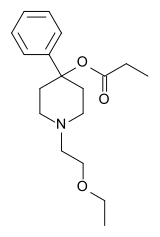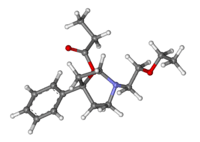Prosidol
Prosidol is an opioid analgesic that is an analogue of prodine. It was originally discovered by J.F. MacFarlan and Co. in the 1950s.[1] It was further developed in Russia in the 1990s during research into the related drug pethidine.[2]
 | |
 | |
| Clinical data | |
|---|---|
| ATC code |
|
| Identifiers | |
IUPAC name
| |
| PubChem CID | |
| ChemSpider | |
| Chemical and physical data | |
| Formula | C18H27NO3 |
| Molar mass | 305.42 g/mol g·mol−1 |
| 3D model (JSmol) | |
SMILES
| |
InChI
| |
| (verify) | |
Prosidol has seen some clinical use, but is still a relatively new drug and does not yet have an extensive history of use. It produces similar effects to other opioids, such as analgesia and sedation, along with side effects such as nausea, itching, vomiting and respiratory depression which may be harmful or fatal.[3][4]
References
- US Patent 2960507 - Piperidine compounds
- Osipova NA, Novikov GA, Vetsheva MS, Prokhorov BM, Beresnev VA, Loseva NA, Zemskaia SIu, Smolina TA. First experience in the use of a new Russian narcotic analgesic prosidol in oncology. (Russian) Anesteziologiia i Reanimatologiia. 1994 Jul-Aug;(4):53-7.
- Osipova NA. The problem of opioid tolerance and dependence during clinical use thereof. (Russian) Anesteziologiia i Reanimatologiia. 1996 Jul-Aug;(4):17-21.
- Abuzarova GR. Prosidol, an original Russian opioid, in the treatment of pain syndromes. (Russian) Anesteziologiia i Reanimatologiia. 2001 Sep-Oct;(5):74-7.
This article is issued from
Wikipedia.
The text is licensed under Creative
Commons - Attribution - Sharealike.
Additional terms may apply for the media files.